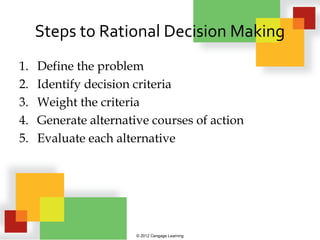Signaler
Partager

Recommandé
Recommandé
Contenu connexe
En vedette
En vedette (7)
Webinaire : les soins pour la peau - TENAQUIP et GOJO

Webinaire : les soins pour la peau - TENAQUIP et GOJO
Similaire à Decisionmaking
Similaire à Decisionmaking (20)
Decision_Making_group_and process how to start a group decision

Decision_Making_group_and process how to start a group decision
Management - Chapter 7 : Individual & Group Decision Making

Management - Chapter 7 : Individual & Group Decision Making
Decision Making - Basic Farm Management - LeadFarm Project

Decision Making - Basic Farm Management - LeadFarm Project
Decisionmaking
- 1. Steps to Rational Decision Making 1. Define the problem 2. Identify decision criteria 3. Weight the criteria 4. Generate alternative courses of action 5. Evaluate each alternative © 2012 Cengage Learning
- 2. Limits to Rational Decision Making • In theory, fully rational decision makers maximize decision by choosing the optimal solution. • In practice, limited resources make it nearly impossible to maximize decisions. © 2012 Cengage Learning
- 3. Advantages of Group Decision Making Groups do a better job than individuals at • Defining the problem • Generating alternative solutions © 2012 Cengage Learning
- 4. Pitfalls of Group Decision Making • Groupthink – occurs in highly cohesive groups when group members feel intense pressure to agree with each other so that the group can approve a proposed solution • Takes considerable time • Strong willed members © 2012 Cengage Learning
Notes de l'éditeur
- Whereas maximizing is choosing the best alternative, satisficing is choosing a “good enough” alternative. In reality, however, the manager’s limited time, money, and expertise mean that only a few alternatives will be assessed against a few decision criteria.
- Groupthink is most likely to occur under the following conditions: • The group is insulated from others who might have different perspectives. • The group leader begins by expressing a strong preference for a particular decision. • The group has no established procedure for systematically defining problems and exploring alternatives. • Group members have similar backgrounds and experiences.